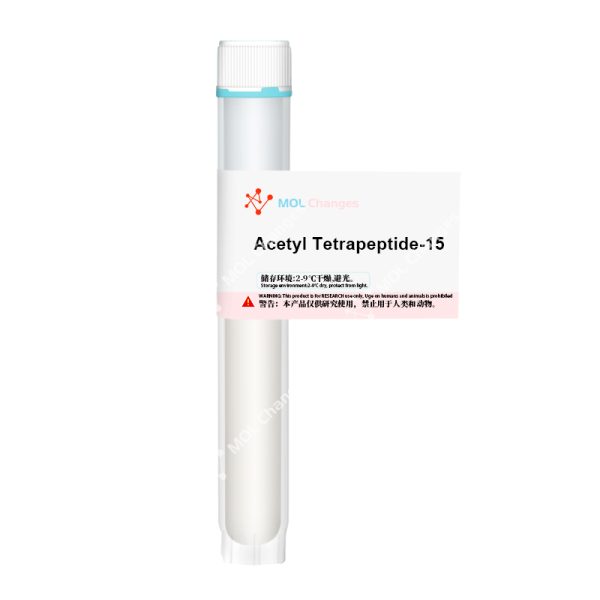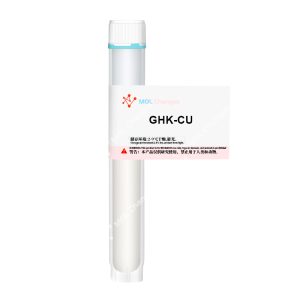Acetyl Tetrapeptide-15 is derived from endomorphin-2 through an acetylation modification at its N-terminal tyrosine residue. This specific chemical modification is commonly used to either enhance peptide stability or alter its biological activity.
Endomorphin-2 itself is a well-documented endogenous agonist with high affinity and selectivity for the μ-opioid receptors (MOR) as its defining characteristics. Due to its structural similarity to this parent compound, Acetyl Tetrapeptide-15 is presumed to possess nearly identical biological functions.
The primary, and to date near exclusive, application of this acetylated peptide falls within the cosmetics industry – sensitive skin products being the most prevalent example of its use as an active ingredient.
序列
Ac-Tyr-Pro-Phe-Phe-NH2
化学文摘社编号
928007-64-1
分子式
C34H39N5O6
分子量
613.70 g/mol
Research Of Acetyl Tetrapeptide-15
The development of acetyl tetrapeptide-15 aims to elevate the excitation threshold of μ-opioid receptor-expressing neurons; endorphin-like pathways being utilized. Enhancing skin tolerance to various external stimuli and reducing inflammatory, chronic and even neuropathic pain related to skin hyperreactivity is the desired end result.
1.Modulating CGRP Release
CGRP (calcitonin gene-related peptide) is a potent pro-inflammatory neuropeptide. Sensory neurons release it, vasodilation and subsequent redness/edema being two direct manifestations of this sensitivity. Skin sensitivity and associated inflammatory responses are at least partially mediated by CGRP.
Activation of the TRPV1 receptor (capsaicin, heat, depolarizing agents all serve as triggers) leads to its release. Co-cultured sensory neurons treated with acetyl tetrapeptide-15 showed a significant inhibition of both capsaicin and Potassium chloride (KCl, or potassium salt) induced CGRP release – the effect being comparable to, or better than, the known TRPV1 antagonist capsazepine.
2.Activation of μ-Opioid Receptors
In an in vitro assay: Within a capsaicin stimulation model, acetyl tetrapeptide-15 competitively bound to μ-opioid receptors on cultured sensory neurons. The opioid antagonist naloxone was used to confirm this binding.
Capsaicin itself binds to TRPV1 receptors, triggering a calcium influx; subsequent CGRP release and pain signaling follow as a result. acetyl tetrapeptide-15 significantly reduced this capsaicin-stimulated CGRP release, the blocking effect of naloxone providing the necessary confirmation of receptor involvement.
Activating these μ-receptors allows acetyl tetrapeptide 15 to negatively modulate sensory neuron activity; pro-inflammatory neuropeptides (CGRP being a prime example) are thus less released. Blocking neurogenic inflammation at its source is an anti-inflammatory end-effect, soothing being another.
3.Clinical Study
A single-blind clinical trial evaluated the ability of acetyl tetrapeptide-15 to reduce skin sensitivity. Increasing concentrations of capsaicin solution were applied to the nasolabial fold (discomfort threshold being the measure of interest), with the contralateral cheek serving as vehicle control.
Repeated applications of the peptide, at 0.0015%, twice daily for four days, followed further capsaicin challenges, showed a clear and measurable increase in that threshold.
Currently the applications of acetyl tetrapeptide-15 are still largely confined to cosmetic formulations. Core anti-sensitization is what it provides; sensitive skin products (to date at least) take this into account.
Burning and stinging are reduced, and to a point, all forms of discomfort or near-normalization of skin sensitivity can be achieved. New topical analgesics andor anti-inflammatory agents are a logical next step, and acetyl tetrapeptide-15 has potential in future dermatological or cosmetic science.
COA
高效液相色谱法
MS









评价
目前还没有评价